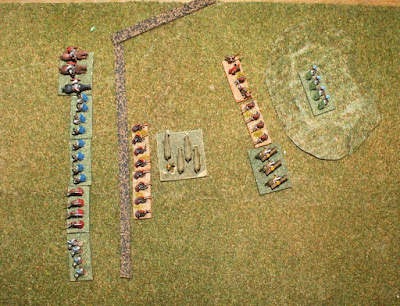Introduction
Interlude
I have been soul searching for a while on why I am actually
using my own rules to play these games.
Originally it was to create some rules that were fast and solo friendly
for a small table and chronologically playing historical battles was a good way
to test them. But more recently it is
the reading of and the playing of the historical battle that if more
important. I still will be using my own
rules as I want something fast and very solo friendly but these historical
battles will be less about the testing of the rules (although they do get
tested by playing the battle scenario) and more about actually playing the
battle. So I expect the rules will
continue to change, they already have gone through three major rewrites anyway!
Between this battle (done back in April 2022) and this one
in September I have played about a dozen games with my 6mm forces on a 12x12
gridded table. These are using a mashup of Phil Sabin’s Phalanx for movement
and my older rules for the reactions and results.
Post script
This is the last outing with a variation of my Ancient
Battles Clash rules. I have been
tweaking them for 12 years and after several hundred games with them I have
moved to my own rules based on Phil Sabin’s Phalanx for movement and 1d6 with
some simple results for combat. The next
replay is with Phalanx and then after that is the mashup.
Battle of Philippi
42BC
The last battle in the Wars of the Second Triumvirate
between the forces of Mark Antony and Octavian.
Troops
Roman Second Triumvirate
Right Wing (Octavian)
3 HI, Legions
1 MC, Cavalry
1 Camp
1 Leader
Left wing (Antony)
5 HI, Legions
1 MC, Cavalry
1 leader
Breakpoint: 11
Roman Liberators
Left wing (Cassius)
4 HI, Legions
1 MC, Cavalry
1 Camp
1 Leader
4 HI, Legions
1 MC, Cavalry
1 Camp
1 Leader
Breakpoint: 11
Reduced the forces by about 80% and flipped the battle map
(the Marsh on the left is now on the right).
Deployment
 |
| Deployment |
Quite a different deployment to the usual battle. There are two wings facing one another but also the flanking force of Antony’s (1 HI in my scenario on top of the hill on the left) is facing most of Cassius forces.
Game
Note: originally I had the narrative going back and forth between each flank. As each flank was a distinct battle I have split the game report into Antony Vs Cassius and Octavian Vs Brutus.
Antony Vs Cassius
 |
| Antony (left) Vs Cassius (right). Antony's flanking force is on the hill |
 |
| Antony and Cassius’s forces engage |
Cassius rearguard forces advance up the hill and are locked in melee with Antony’s flank force.
 |
| Antony’s flank force is engaged by Cassius’s forces |
Antony Vs Cassius sees Antony’s cavalry flank attack a legion that is destroyed, the cavalry pursue and being looting Cassius’s camp.
 |
| Cavalry helps destroy a legion and then loots the camp |
Cassius routs Antony’s flanking force.

Antony flanking force is no more
 |
| Looting the camp |
 |
| Octavian (left) Vs Brutus (right) |
Octavian advances. Brutus also advances legions only into Octavian’s legions, also now all locked in melee. Did not charge the cavalry as that is a straight 1:1 and no advantage there, unlike the legions that is 4 legions to 3.
 |
| Brutus engages with Octavian’s legions |
Octavian manages to rout an opposing legion
 |
| Routed a Brutus legion |
Antony manages to rout the cavalry unit and Octavian routs another legion. This results in the combined Cassius and Brutus army reaching their breakpoint.
 |
| Antony routs Cassius’s cavalry |
 |
| Octavian manages to rout another of Brutus’s legions |
Rule changes
None.
Verdict
I should have done them as two distinct games on the same
table as there is no interaction between the two combats. It then could have had one side win while the
other side loses. Instead it was overall
losses that saw the Liberators lose. It
was a very close game and could have gone either way.
This the last game played with Ancients Battlelines
Clash. They have been fun but I am have
currently moved to 8x8 grids and a mashup of Phil Sabin and 1d6 combat.
So still playtesting via the Peter Sides’ scenarios, but with different
rules! They actually have similar results
but less complex and still reflecting my view of ancient battles.













































































.jpg)



